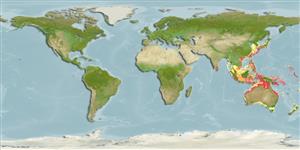Environment: milieu / climate zone / depth range / distribution range
Ekologi
laut dasar (demersal); kisaran kedalaman 13 - 78 m (Ref. 9494), usually 15 - 25 m (Ref. 9774). Tropical
Indo-West Pacific: Indo-Australian Archipelago.
Size / Weight / umur
Maturity: Lm ? range ? - ? cm
Max length : 25.0 cm SL jantan/; (Ref. 9774); common length : 17.5 cm SL jantan/; (Ref. 9774)
Duri punggung (Keseluruhan (total)) : 0; duri punggung lunak (Keseluruhan (total)) : 67 - 72; Duri dubur: 0; Sirip dubur lunak: 51 - 55. Body brownish, 2 double or tripe ocelli above and below lateral line and 1 on posterior third of straight section of lateral line. Many dark spots and rings scattered on body and median fins. Pectoral fin on ocular side with 12-13 rays. Pelvic fins short based, subequal and sub symmetrical in position, posterior 3-4 rays branched.
Inhabits muddy and sandy bottoms (Ref. 9774). Feeds on small benthic animals (Ref. 9774). Caught mainly with bottom prawn trawls (Ref. 9774).
Life cycle and mating behavior
Maturities | Reproduksi, perkembang biakan | Spawnings | Egg(s) | Fecundities | Larva
Distinct pairing (Ref. 205).
Kailola, P.J., 1991. The fishes of Papua New Guinea: a revised and annotated checklist. Vol. III. Gobiidae to Molidae. Research Bulletin No. 41, Research Section, Dept. of Fisheries and Marine Resources, Papua New Guinea. 153 p. (Ref. 6771)
Status IUCN Red List (Ref. 130435)
ancaman kepada manusia
Harmless
penggunaan manusia
Alat, peralatan
laporan khas
muat turun XML
Sumber internet
Estimates based on models
Preferred temperature (Ref.
123201): 24.5 - 29, mean 28 °C (based on 310 cells).
Phylogenetic diversity index (Ref.
82804): PD
50 = 0.5000 [Uniqueness, from 0.5 = low to 2.0 = high].
Bayesian length-weight: a=0.00741 (0.00343 - 0.01604), b=3.17 (3.00 - 3.34), in cm total length, based on LWR estimates for this Genus-body shape (Ref.
93245).
Trophic level (Ref.
69278): 3.5 ±0.37 se; based on food items.
Daya lenting (Ref.
120179): Tinggi, Waktu penggandaan populasi minimum kurang dari 15 bulan (Preliminary K or Fecundity.).
Fishing Vulnerability (Ref.
59153): Low vulnerability (21 of 100).
